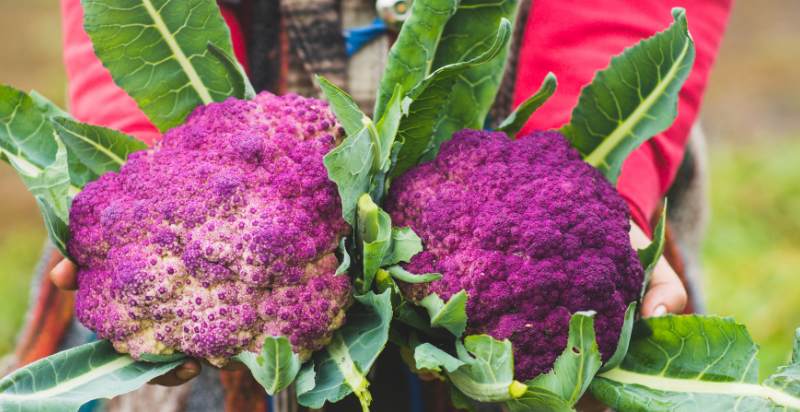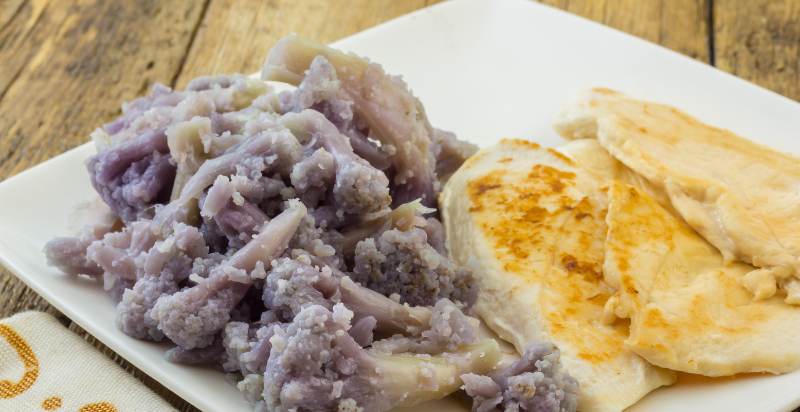Purple cauliflower is a unique variety of the traditional white cauliflower plant. It has a striking deep purple hue and is just as nutritious as its white counterpart. This vegetable has been gaining popularity, adding a splash of color to salads, side dishes, and more! In this article, we will explore purple cauliflower’s nutritional content and health benefits and discuss how to incorporate it into your diet.
What is a Purple Cauliflower?
Purple cauliflower is a variety of cauliflower that has a deep purple color. It is the same species as white cauliflower but contains anthocyanins, giving it its vibrant hue. This vegetable is slightly sweeter than traditional white cauliflower and can be easily found in most grocery stores.

History and Origin of the Purple Cauliflower:
The purple cauliflower, also known as the Graffiti Cauliflower, was first developed in Canada in the late 1980s by a scientist-led team by Dr. Gary Taylor at the University of Alberta. This unique variety is created through genetic modification and cross-breeding techniques, resulting in a hybrid that produces gray-to-purple florets.
The Purple Cauliflower is visually striking and rich in nutrients and antioxidants compared to its white counterparts. It contains a higher concentration of anthocyanins than other cauliflowers, which are responsible for the unique purple hue and its antioxidant properties. The anthocyanin content also makes it a healthier choice, with the added benefit of being lower in glucosinolates. Purple Cauliflower is easier to digest and less likely to cause gastrointestinal distress than other varieties.
Appearance of Purple Cauliflower:
Makes it the perfect addition to any plate, especially when combined with other brightly-colored vegetables. Its flavor is mild and sweet, making it easy to incorporate into various dishes. It can be grilled, roasted, added to stir-fries, or used in soups and salads. The purple hue also makes for an eye-catching side dish or main entrée that will certainly impress guests at your dinner table.
Taste of Purple Cauliflower:
Purple cauliflower is sweet yet slightly nutty, with a slight crunch when raw. When cooked, it becomes creamy and tender. Purple cauliflower tastes similar to that of its white counterpart but tends to be milder and more delicate in flavor. Because of its subtle flavor, it’s a great choice for adding color to dishes without overpowering the other ingredients. It pairs well with bold flavors like garlic , ginger spices and cheeses like cheddar or feta.
Plant Characteristics of Purple Cauliflower:
Purple cauliflower is a type of Brassica oleracea, a species that includes broccoli, kale, and cabbage. It’s distinguished by its purple-brown coloration on the outside and white head with deep purple streaks inside. This type of cauliflower grows quite large compared to other varieties, and its leaves are more open and frilly than standard white cauliflower. Purple cauliflower is often found in farmers’ markets in spring or fall.
Health Benefits of Purple Cauliflower:
In addition to being low in calories, purple cauliflower contains several plant compounds that are beneficial for health. These include anthocyanins with powerful antioxidant properties that can help protect against inflammation and disease. This cruciferous vegetable is also high in vitamin C, which can help boost immunity and promote healthy skin. Furthermore, purple cauliflower is a good source of dietary fiber which can aid digestion and help lower cholesterol levels. Eating it regularly can also benefit heart health.
Where are Purple Cauliflower Grown and Harvested?
Purple cauliflower is typically grown and harvested in the United States, Europe, Australia, India, Mexico, and Africa. It can grow in fields or gardens in most temperate climates during the late summer and early fall months. In some areas, it may also be grown through the winter if given proper protection from extreme temperatures.
When harvested, the purple-colored heads are cut off at the stem and then trimmed to a uniform size. The leaves are also harvested for use in salads or as garnishments. After harvest, the heads are graded for imperfections and packed into crates and boxes for shipping to grocery stores, restaurants, and other food establishments.

Where can the Best Quality Purple Cauliflower be found?
The best quality Purple Cauliflower can be found in specialty market stores or online. Look for heads with a deep, lavender-purple hue and firm texture. Also, check that the leaves are bright green, not yellow or wilted. If you purchase from an online source, make sure to read the reviews carefully before making your selection.
Buying organic, locally-grown Purple Cauliflower is also a great option as it’s closer to its natural state and may be fresher than mass-produced varieties. Additionally, look for stores that offer bulk purchasing options – you can get more cauliflower for your money.
What is the Best Way to Store Purple Cauliflower?
The best way to store purple cauliflower is to wrap it in damp paper towels and place it in an airtight container or plastic bag. Make sure the container or bag is labeled so you know what type of vegetable you have stored. Store the cauliflower in a cool, dry place for 2 weeks. If you need to store it longer, the cauliflower can be kept in the refrigerator for up to 2 months.
What are some ways to Use Purple Cauliflower?
Purple cauliflower is an incredibly versatile vegetable that can be used in various dishes such as other veggies like carrots, onions, garlic, and peppers. It makes a great addition to salads, stir-fries, side dishes, and even main courses. Roasting it brings out its sweetness and gives it a beautiful caramelization. You can also steam or sauté purple cauliflower for a healthy side dish.
If you want to add more color to your meal, try adding it to macaroni and cheese or a pasta salad. You can also blend it into soups or puree it for sauces. For something sweet, try mashing purple cauliflower with butter and adding seasonings like cinnamon or nutmeg for a great dessert.

Conclusion:
Purple cauliflower is a versatile and unique vegetable that can add color to any plate. Its sweet flavor makes it ideal for adding to salads, sides, main dishes, desserts, and more. There are endless possibilities when it comes to cooking with purple cauliflower! Try experimenting with different recipes and find your favorite way to enjoy this delicious superfood.
- Everything You Wanted to Know About Red Tamarillos - June 2, 2025
- A Guide to Tulips: Everything You Need to Know & More… - June 2, 2025
- Guanabana: Description, Flavor, Benefits, And Uses - May 27, 2025

6 thoughts on “Purple Cauliflower: Description, Flavor, Benefits, And Uses”
Comments are closed.